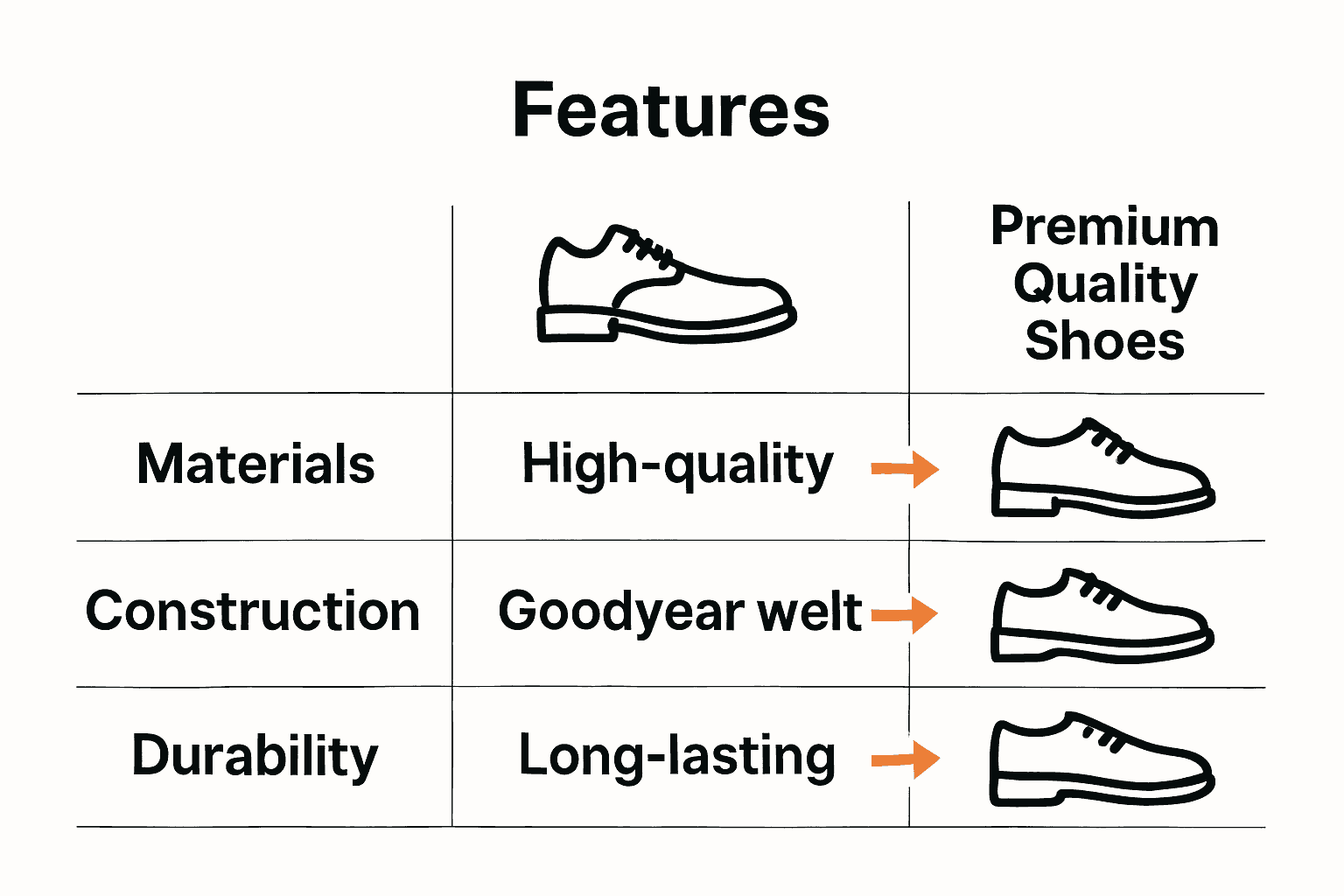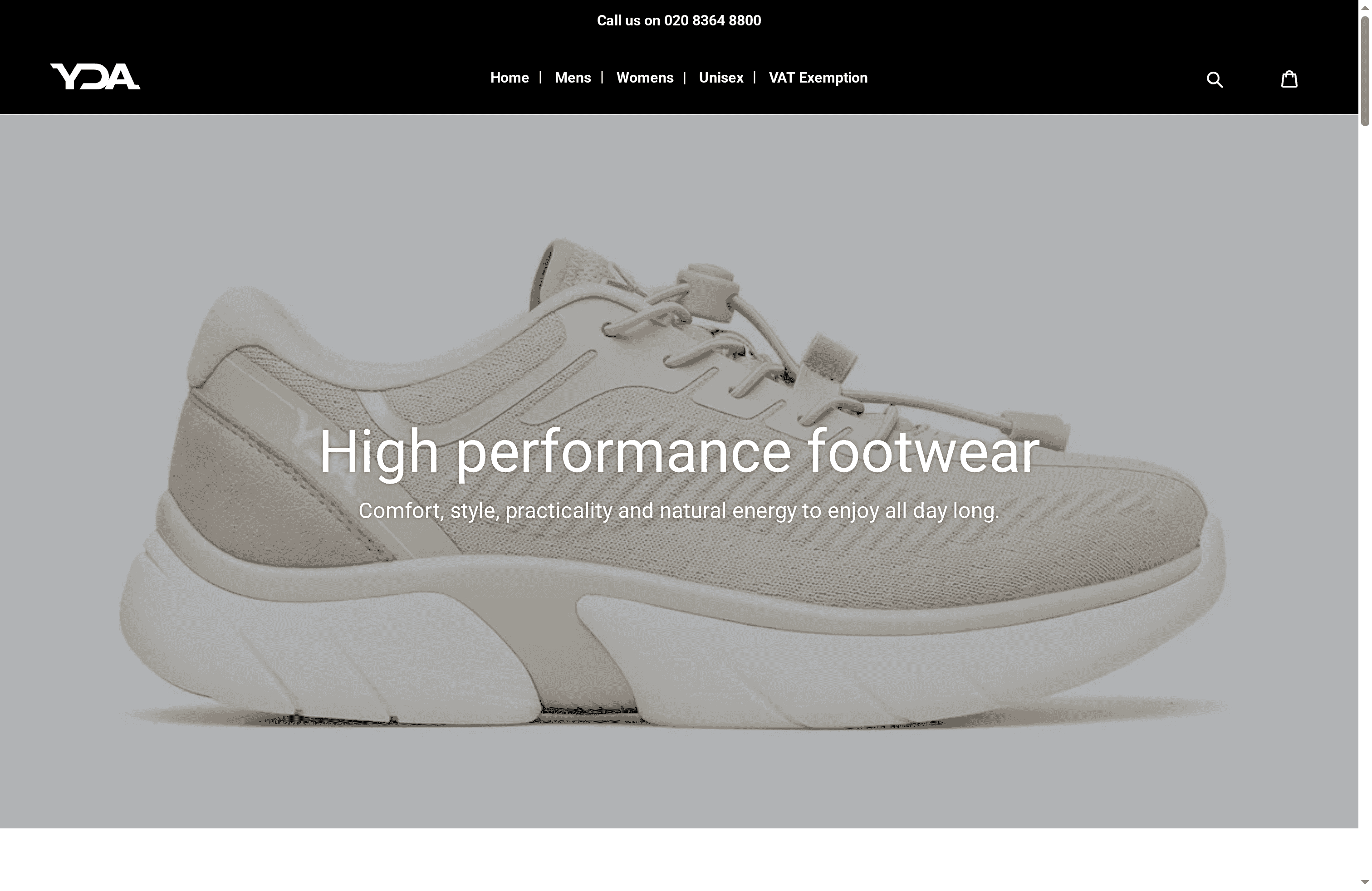Why Invest in Quality Shoes: The Essential Guide
Did you know that over 70 percent of people admit discomfort from poorly made shoes affects their day? Shoes play a much bigger role in daily life than many realize. Your choice in footwear shapes not only style but also long-term health, comfort, and even your wallet. Discover how recognizing true quality in shoes can help prevent common mistakes and lead to smarter choices for everyday wear.
Table of Contents
- Defining Quality Shoes And Common Myths
- Types Of Quality Shoes And Their Purposes
- Key Health And Comfort Benefits Explained
- Long-Term Cost Savings And Value
- Comparing Quality Shoes To Cheaper Alternatives
Key Takeaways
| Point | Details |
|---|---|
| Quality Measurement | Quality shoes are defined by durable materials, superior construction, and comfort, not just price or brand. |
| Health Benefits | High-quality footwear supports proper posture and reduces the risk of injuries, making them essential for foot health. |
| Long-Term Value | Investing in quality shoes offers significant savings over time due to durability and reduced replacement costs. |
| Informed Choices | Understanding the differences between premium shoes and budget alternatives empowers consumers to make better footwear decisions. |
Defining Quality Shoes and Common Myths
Understanding what truly constitutes quality footwear goes far beyond price tags and brand names. According to ssia, quality shoes are fundamentally characterized by durable materials and superior construction techniques that ensure longevity and comfort.
Many consumers fall into the trap of believing that a higher price automatically guarantees better quality. However, lacelab reveals this is a common misconception. Not all expensive shoes represent exceptional craftsmanship, and conversely, some affordable options can deliver remarkable durability and comfort.
Let’s break down the key characteristics of truly quality footwear:
- Material Integrity: Genuine leather, high-grade synthetic materials that resist wear
- Construction Techniques: Precision stitching like Goodyear welt, reinforced stress points
- Comfort Engineering: Proper arch support, cushioned insoles, breathable design
- Durability Indicators: Solid sole attachment, quality stitching, resilient outer materials
Understanding these factors empowers you to make intelligent footwear choices that prioritize both performance and long-term value. Forget the myth that price equals quality. Smart shoe shopping means evaluating each element meticulously.
Types of Quality Shoes and Their Purposes
Quality footwear isn’t a one-size-fits-all concept. Different shoes serve unique purposes, designed to meet specific lifestyle and functional requirements. Dress shoes, for instance, as described by en, are meticulously crafted for formal occasions, emphasizing sophistication and style while providing a polished appearance for professional and social settings.
Beyond traditional styles, innovative shoe designs like minimalist shoes have emerged to revolutionize how we think about footwear. According to en, these barefoot-style shoes aim to replicate natural foot movement, offering enhanced sensory ground contact while protecting feet from potential hazards. This approach represents a significant shift from conventional shoe design, focusing on biomechanical efficiency and natural movement patterns.
Let’s explore the diverse landscape of quality shoe types:
- Formal Shoes: Oxfords, Derbies - Perfect for professional environments
- Athletic Shoes: Running, cross-training, sport-specific designs
- Casual Wear: Comfortable everyday shoes with versatile styling
- Specialized Footwear: Minimalist shoes, orthopedic designs, performance-focused models
- Work Boots: Safety-oriented shoes with reinforced protection
Choosing the right shoe isn’t just about aesthetics—it’s about matching your footwear to your lifestyle, movement patterns, and specific functional needs. Understanding the nuanced purposes of different shoe types empowers you to make informed decisions that support your comfort, performance, and personal style.

Key Health and Comfort Benefits Explained
Investing in high-quality shoes is more than a fashion statement—it’s a critical decision for your physical well-being. According to piraloff, these shoes provide essential cushioning and alignment that promote healthy posture and significantly reduce impact on your joints, supporting your body’s natural biomechanical structure.
Consumer research highlights the paramount importance of comfort in footwear selection. simon-kucher indicates that fit and comfort are primary considerations for most people when purchasing shoes, underscoring that well-designed footwear isn’t a luxury—it’s a necessity for maintaining foot health and overall physical comfort.
The profound health benefits of quality shoes extend far beyond immediate comfort:
- Posture Protection: Correct alignment prevents spine and joint stress
- Impact Absorption: Reduces strain during walking, running, and daily activities
- Injury Prevention: Minimizes risks of foot, ankle, and knee complications
- Circulation Support: Proper design promotes better blood flow
- Biomechanical Efficiency: Enables natural foot movement and muscle engagement
Think of quality shoes as an investment in your body’s long-term performance and well-being. They’re not just accessories, but critical tools that support your mobility, protect your physical health, and enhance your daily comfort and potential.
Long-Term Cost Savings and Value
The initial investment in high-quality footwear might seem steep, but the financial wisdom becomes clear when you examine long-term value. According to piraloff, quality shoes provide significantly greater value over time due to their exceptional durability, ultimately reducing the frequency of replacements and saving money in the long run.
Quality isn’t just about immediate performance—it’s a strategic financial decision. ssia emphasizes that shoes constructed with superior materials and advanced techniques ensure remarkable longevity, offering substantially better cost efficiency compared to cheaper alternatives that quickly wear out and require frequent replacement.
Let’s break down the financial mathematics of quality shoe investment:
- Durability Savings: Higher-quality shoes last 2-3 times longer than budget options
- Maintenance Costs: Better construction means fewer repairs and replacements
- Performance Consistency: Maintained structural integrity prevents premature wear
- Health Cost Avoidance: Reduced risk of foot-related medical issues
- Versatility: Multi-purpose designs maximize utility and reduce overall footwear expenses
Think of quality shoes as a strategic investment—not an expense. By choosing wisely, you’re not just buying footwear; you’re making a financially prudent decision that delivers long-term comfort, performance, and economic benefits.
Comparing Quality Shoes to Cheaper Alternatives
The difference between quality shoes and budget alternatives is far more significant than just price. According to woil, premium footwear stands out through superior construction techniques like full-grain leather and Goodyear welt construction, while cheaper shoes typically rely on synthetic materials and inferior glued soles that deteriorate rapidly.
Fit and comfort represent another critical distinguishing factor. ssia highlights that quality shoes offer comprehensive sizing options, ensuring proper fit across various foot shapes and sizes. Cheaper alternatives often provide limited sizing, potentially leading to discomfort and potential long-term foot health complications.
Key comparative differences include:
Here’s a comparison of premium quality shoes and budget alternatives:
| Feature | Premium Quality Shoes | Budget Alternatives |
|---|---|---|
| Material Quality | Full-grain leather Natural fibres |
Synthetic materials Plastics |
| Construction Method | Goodyear welt Hand-stitched |
Glued bonds Machine assembly |
| Sizing Flexibility | Multiple lengths & widths | Standard sizing only |
| Durability | 2-3 times longer wear | Quick deterioration |
| Comfort | Ergonomic support Cushioned sole |
Minimal support |
- Material Quality: Full-grain leather vs. synthetic materials
- Construction Method: Goodyear welt vs. basic glued construction
- Sizing Flexibility: Multiple width and length options vs. standard sizing
- Durability: Extended lifespan vs. quick deterioration
- Comfort: Ergonomic design vs. minimal support

Ultimately, choosing quality shoes isn’t about spending more—it’s about investing wisely in footwear that supports your health, comfort, and long-term well-being. The initial higher cost translates into superior performance, reduced replacement frequency, and enhanced personal comfort.
Step Into Lasting Comfort and Style with Quality Shoes
The article highlights the challenge of finding footwear that combines durability, comfort and foot health without falling for overpriced brands or cheap imitations. You want shoes that support your posture and reduce strain while lasting for years. At YDA UK, we understand these key goals and offer a carefully selected collection featuring innovative shoes designed for everyday wear with advanced foot health technology. Our designs prioritise ergonomic support, breathable materials and long-term durability so you stay comfortable no matter your routine.

Discover the smart choice by exploring our womens range or browse the full collection today. Don’t settle for less when it comes to your feet’s well-being. Visit YDA UK now and invest in shoes that deliver real value and style every step of the way.
Frequently Asked Questions
What characteristics define quality shoes?
Quality shoes are characterized by durable materials, superior construction techniques, proper comfort engineering, and indicators of durability such as solid sole attachment and quality stitching.
How do quality shoes contribute to health and comfort?
Investing in quality shoes promotes healthy posture, reduces strain on joints, minimizes injury risks, and supports better circulation, significantly enhancing overall foot health and comfort.
Are expensive shoes always of better quality than cheaper alternatives?
No, a higher price does not automatically guarantee better quality. Some affordable shoes can offer remarkable durability and comfort, while not all expensive shoes represent exceptional craftsmanship.
How do I know if a shoe is right for my lifestyle and needs?
Consider the shoe type in relation to your activities. For instance, formal shoes are suitable for professional settings, athletic shoes for sports, and minimalist shoes for natural movement. Choosing the right shoe involves matching it to your specific lifestyle and functional requirements.
